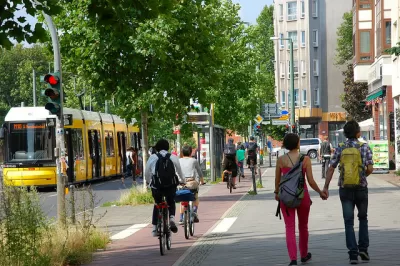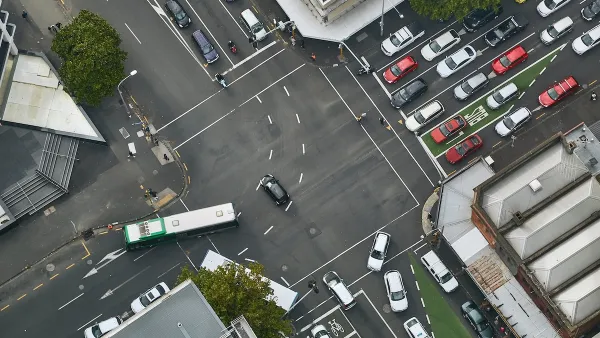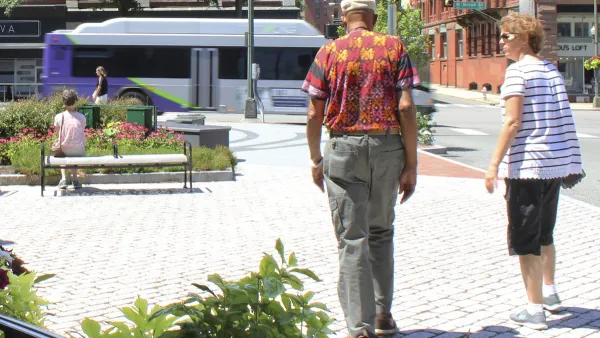The complete streets movement calls for streets to be designed—or redesigned—in order to accommodate a broad range of users and uses.

By Josh Stephens
In many ways, it is easier to describe what a complete street isn’t than what it is. A non-complete street primarily serves the through-put of automobiles. If pedestrians, bicyclists, transit riders, and diners at sidewalk cafes can use streets too without risking bodily harm or aesthetic offense, so be it. But those uses are, on the vast majority of American streets, incidental.
A new movement has been fighting against this transportation myopia. The complete streets movement calls for streets to be designed—or redesigned—in order to accommodate a broad range of users and uses. Bike lanes make streets more complete. So do enhanced crosswalks, lands aping, and sidewalks that accommodate disabled people. The possibilities are endless for cities that want to save lives and choose to view their streets as more than just thoroughfares.
“Every time you touch the transportation system, you should consider complete streets,” said Emiko Atherton, executive director of the National Complete Streets Coalition (NCSC). “It’s about changing the way we look at transportation planning.”
Traffic calming measures like bumps, humps, curves, bollards, roundabouts, and chicanes—obstacles or curves deliberately placed in the flow of automobile traffic—can make streets more complete. So can dedicated lanes for transit and enhanced stops. Improved signage and pavement markings make streets more complete. In commercial areas, widened sidewalks and shade trees make them more complete. Two-way streets are preferable to one-way streets.
At its most extreme, a complete street might be a woonerf. Devised in the Netherlands, a woonerf does away with all features that privilege the automobile over other forms of transportation. Usually narrow and intricately landscaped, every centimeter of a woonerf can be occupied by any type of user. Traffic does not necessarily flow quickly, but it flows pleasantly and safely.
But streets don’t have to go full woonerf to be more complete. There is no such thing as “a” complete street. No single street is “complete.” Complete streets encompasses more of an idea—and an attitude—than a typology.
Even in the United States, that attitude is catching on.
To read the full article, click here to visit InTransition magazine's website.
FULL STORY: Creating Complete Streets

Planetizen Federal Action Tracker
A weekly monitor of how Trump’s orders and actions are impacting planners and planning in America.

Map: Where Senate Republicans Want to Sell Your Public Lands
For public land advocates, the Senate Republicans’ proposal to sell millions of acres of public land in the West is “the biggest fight of their careers.”

Restaurant Patios Were a Pandemic Win — Why Were They so Hard to Keep?
Social distancing requirements and changes in travel patterns prompted cities to pilot new uses for street and sidewalk space. Then it got complicated.

Platform Pilsner: Vancouver Transit Agency Releases... a Beer?
TransLink will receive a portion of every sale of the four-pack.

Toronto Weighs Cheaper Transit, Parking Hikes for Major Events
Special event rates would take effect during large festivals, sports games and concerts to ‘discourage driving, manage congestion and free up space for transit.”

Berlin to Consider Car-Free Zone Larger Than Manhattan
The area bound by the 22-mile Ringbahn would still allow 12 uses of a private automobile per year per person, and several other exemptions.
Urban Design for Planners 1: Software Tools
This six-course series explores essential urban design concepts using open source software and equips planners with the tools they need to participate fully in the urban design process.
Planning for Universal Design
Learn the tools for implementing Universal Design in planning regulations.
Heyer Gruel & Associates PA
JM Goldson LLC
Custer County Colorado
City of Camden Redevelopment Agency
City of Astoria
Transportation Research & Education Center (TREC) at Portland State University
Camden Redevelopment Agency
City of Claremont
Municipality of Princeton (NJ)





























